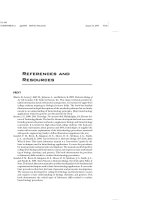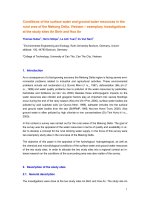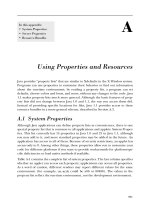References and Resources
Bạn đang xem bản rút gọn của tài liệu. Xem và tải ngay bản đầy đủ của tài liệu tại đây (187.34 KB, 19 trang )
P1: 000
GGBD030REF.tex ggbd030 GR3542/Shmaefsky August 24, 2006 16:28
References and
Resources
PRINT
Alberts, B., Lewis, J., Raff, M., Johnson, A., and Roberts, K. 2002. Molecular Biology of
the Cell. London, UK: Taylor & Francis, Inc. This classic textbook provides de-
tailed information about cell function and genetics. It is written for upper-level
college students majoring in biological science fields. The book has detailed
illustrations and in-depth descriptions of the metabolic pathways that are funda-
mental to an understanding of biotechnology principles. Many biotechnology
applications related to genetics are discussed in the book.
Alcamo, I. E. 2000. DNA Technology: The Awesome Skill. Philadelphia, PA: Elsevier Sci-
ence & Technology Books. The late Dr. Alcamo developed this book as a reader-
friendly general education textbook to supplement biology and biotechnology
coursework. It is written for high school and college students. The book pro-
vides basic information about genetics and DNA technologies. It supplies the
reader with accurate explanations of the biotechnology procedures associated
with genetic engineering. Easily to follow illustrations supplement the text.
Ausubel, F. M., Brent, R., Kingston, R. E., Moore, D. D., Seidman, J. G., Smith,
J. A., and Struhl, K. 1989. Current Protocols in Molecular Biology.NewYork:John
Wiley & Sons. This classic laboratory manual is a “how-to-do-it” guide for the
basic techniques used in biotechnology applications. It covers the procedures
for many genomic and proteomic investigations. The manual was developed for
college-level biology and biochemistry courses and requires a basic understand-
ing of biology, chemistry, and genetics. This book demonstrates the precision
in laboratory skills needed to conduct biotechnology procedures.
Ausubel, F. M., Brent, R., Kingston, R. E., Moore, D. D., Seidman, J. G., Smith, J. A.,
and Struhl, K. 1989. Short Protocols in Molecular Biology.NewYork:JohnWiley&
Sons. This classic laboratory manual is an abbreviated guide for the fundamental
experimental techniques used in basic biotechnology applications. It covers the
basic procedures that form the basis of genomic and proteomic investigations.
The manual was developed for college-level biology and biochemistry courses
and requires a basic understanding of biology, chemistry, and genetics. This
book demonstrates the critical types of laboratory skills needed to conduct
biotechnology procedures.
P1: 000
GGBD030REF.tex ggbd030 GR3542/Shmaefsky August 24, 2006 16:28
236 References and Resources
Bains, W. 1998. Biotechnology: From A to Z.2nded.NewYork:OxfordUniversityPress.
This basic book covers—defines and describes—many terms associated with
biotechnology applications and research. It serves as a simple-to-understand
handbook of the techniques common to genomics and proteomics. Most of the
basic concepts needed to understand newsworthy biotechnology are covered in
this book. Practical applications contemporary to the publication date of the
book are mentioned for each technique described.
Barker, P. 1995. Genetics and Society. New York: The H. W. Wilson Company. This book
investigates the societal issues associated with biotechnology applications and
discoveries. Information about genetics has created much controversy in society
dating back to the earliest discoveries of inheritance. The author provides an
unbiased view of the various social concerns that result from genetic research.
Many of the issues discussed in the book are still contemporary concerns raised
by recent biotechnology developments.
Baxevanis, A. D., and Francis, O. B. F. (eds). 2004. Bioinformatics: A Practical Guide to
the Analysis of Genes and Proteins. New York: John Wiley & Sons. This book is a tech-
nical compendium of bioinformatics applications. It is targeted at researchers
interested in computer applications used for interpreting information gathered
from genomic and proteomic studies. The book gives a good idea of the types
of research being performed in bioinformatics. It also provides insights into
future applications of bioinformatics.
Begemann, Brett D. 1997. Competitive Strategies of Biotechnology Firms: Implica-
tions for US Agriculture. Journal of Agricultural and Applied Economics 29:117–122.
This journal article is written for owners of biotechnology firms interested in
agricultural biotechnology. It provides information about current and future
agricultural needs that can be solved with biotechnology developments. The ar-
ticle is written for a technical audience with a business or scientific background.
However, it does provide the general reader good insight into the growth of
agricultural biotechnology.
Bonnicksen, A. L. 2002. Crafting a Cloning Policy: From Dolly to Stem Cells. Washington,
DC: Georgetown University Press. This well-written scholarly book provides a
rational analysis of governmental regulations of cloning and other genetic tech-
nologies. The author discusses the importance of developing rational biotech-
nology policies that permit the growth of science while protecting the well-
being of the public. It is a good book for understanding how science policy is
determined.
Borem, A., Santos, F. R., and Bowen, D. E. 2003. Understanding Biotechnology.San
Francisco, CA: Prentice Hall. This book is a simple-to-read introduction to
biotechnology. It gives a brief history of major biotechnology events and an
introduction to the fundamental principles of genetic engineering. Many of
the critical areas in contemporary genomic research are discussed. It is written
for a nontechnical audience wishing to understand everyday applications of
biotechnology.
Bourgaize, D., Jewell, T. R., and Buiser, R. G. 1999. Biotechnology: Demystifying the
Concepts. San Francisco, CA: Pearson Education. This basic biotechnology book
investigates the ethical, political, and social issues raised in various fields of
biotechnology. It covers the basic science needed to understand the biotech-
nology applications and procedures mentioned in the book. It is a well-written
P1: 000
GGBD030REF.tex ggbd030 GR3542/Shmaefsky August 24, 2006 16:28
References and Resources 237
book that provides a comprehensive summary of biotechnology applicable to
high school and college students.
Burrill, G. S., and Lee, K. B., Jr. 1991. Biotech ’92: Promise to Reality, An Industry
Annual Report. San Francisco, CA: Ernst & Young. This annual report written
for business people shows the investment promises of early biotechnology ap-
plications. The report presents earlier technologies that led to the multitude
of industries present today. It covers the rationale that investors use to develop
various technologies. In addition, it gives good insight into the way scientific
discoveries are used for industrial applications.
Butterfield, H. 1965. The Origins of Modern Science 1300–1800. London, UK: Free
Press. This classical historical reference is an authoritative book on the early
history of European science. It discusses the factors that led to the great discov-
eries following the Renaissance period. Many noted scientists who produced
the foundations of biotechnology are discussed in detail. The book was written
for a general audience as well as historians.
Chrispeels, M. J., and Sadava, D. E. 2002. Plants, Genes, and Crop Biotechnology.2nd
ed. Sudbury, MA: Jones and Bartlett Publishers. This college-level introduc-
tory biotechnology focuses on agricultural biotechnology related to crop pro-
duction. It covers contemporary information on genomic and proteomic tech-
niques used to improve crop plants. Basic botany principles provided to explain
the biotechnology information are covered in the book. The book contains
many useful illustrations that depict the biotechnology techniques discussed.
Cohen, D. 1998. Cloning. Brookfield, CT: Millbrook Press. This classical ethics book
evaluates the social implications of biotechnology applications of cloning. The
book is written for younger readers and discusses the history and current devel-
opments of cloning, gene therapy, and recombinant DNA technologies. It also
examines the ethical ramifications of genomic procedures used on animals,
humans, and plants.
Cohen, I. B. 1985. Revolution in Science. Cambridge, MA: Harvard University Press.
In this book the author provides an understanding of the ways in which scien-
tific revolutions are born. The book chronicles scientists who challenged the
contemporary scientific ideologies to come up with many innovations that led
to the field of biotechnology. This book is written for scholars and for general
readers.
Conko, G. 2003. Regulation: The Benefits of Biotech. Washington, DC: Cato Institute.
This report is prepared by the Cato Institute that promotes American pub-
lic policy based on individual liberty, limited government, free markets, and
peaceful international relations. The social benefits of modern developments
in biotechnology are analyzed and discussed in this book. It was written for
business people and policymakers.
Ellyn, Daugherty. 2006. Biotechnology: Science for the New Millennium. 1st ed. St. Paul,
MN: EMC/Paradigm Publishing. This general biotechnology textbook is de-
signed for high school and college level introductory biotechnology courses. It
is simple to read and provides contemporary examples of each biotechnology
topic covered. The book also provides a brief background of the biology and
chemistry principles needed to understand the scientific principles of biotech-
nology. It is accompanied by a laboratory manual, which shows inexpensive
laboratories that model biotechnology techniques.
P1: 000
GGBD030REF.tex ggbd030 GR3542/Shmaefsky August 24, 2006 16:28
238 References and Resources
Davis, J. 1990. Mapping the Code: The Human Genome Project and the Choices of Modern
Science. New York: John Wiley & Sons. This book investigates the scientific discov-
eries and philosophies that led to the initiation of the Human Genome Project.
It is written for a general audience and requires no scientific background to
read. The book is a good historical reference of the period of time when the
Human Genome Project was just getting underway.
DeGregori, T. R. 2003. Bountiful Harvest: Technology, Food Safety and the Environment.
Washington, DC: Cato Institute. This report is produced by Cato Institute that
promotes American public policy based on individual liberty, limited govern-
ment, free markets, and peaceful international relations. It describes the eco-
nomic and social benefits of agricultural biotechnology. The book discusses the
benefits of modern biotechnology developments in agriculture. It was written
for business people and policymakers.
Department of Energy. 1992. Primer on Molecular Genetics. Washington, DC: U.S. De-
partment of Energy, Office of Energy Research and Office of Environmental
Research. This government publication provides reading about the basic bi-
ology and chemistry needed to understand the Human Genome Project. The
Department of Energy provided funding for the Human Genome Project and
this book is part of their public education commitment to the project. It is
written for a general audience.
Diamond, J. 1999. Guns, Germs and Steel: The Fates of Human Societies.NewYork:
Norton, W. W. & Company, Inc. This fascinating book is a biologist’s perspec-
tive on the effects of science and technology on human civilization. The au-
thor evaluates the social conditions that drive scientific advancements such as
biotechnology. Also covered in this book are the impacts of technology on
cultural attitudes and public health.
Drexler, K. E. 1996. Engines of Creation: The Coming Era of Nanotechnology.NewYork:
Anchor Books. This book discusses the early investigations and inventions of
nanotechnology. It provides good insight into the rationale used to make nan-
otechnology inventions. The book focuses on several of the biotechnology
applications of nanotechnology. Many of the technologies mentioned in the
book are now in development.
Durbin, P. T. (ed). 1980. A Guide to the Culture of Science, Technology & Medicine.
London, UK: Free Press. This classical book evaluates the strategies scientists
use when making new scientific discoveries. It helps explain why certain scien-
tists are responsible for many of the great scientific theories and technologies.
The book also looks into the driving force behind the growth of genetics and
biotechnology.
Etherton, T. D., Bauman, D. E, Beattie, C. W., Bremel, R. D, Cromwell, G. L.,
Kapur, V., Varner, G., Wheeler, M. B., Wiedmann, M. 2003. Biotechnology in An-
imal Agriculture: An Overview. Ames IA: Council for Agricultural Science and
Technology. This book written for the Council for Agricultural Science and
Technology fulfills its mission to interpret and communicate scientific informa-
tion about agricultural nationally and internationally. Covered in this book are
current technological advances in biotechnology used in animal agriculture.
The report was prepared for business people, policymakers, and the public.
European Commission. 1997. Biotechnology (1992–1994). Final Report, Vol. 1. Brus-
sels: Directorate-General Research. This report was prepared as an educational
P1: 000
GGBD030REF.tex ggbd030 GR3542/Shmaefsky August 24, 2006 16:28
References and Resources 239
document for European government officials. It investigates and evaluates the
status of biotechnology growth in between 1992 and 1994. This period rep-
resents a rapid growth of biotechnology industries in Europe and the United
States. It is an informative document that provides an insight into the govern-
ment’s concerns on biotechnology.
European Commission. 1997. Biotechnology: 1994–1998. Progress Report 1997. Brus-
sels: Directorate-General Research. This report was prepared as an educational
document for European government officials. It investigates and evaluates the
status of biotechnology growth in between 1994and 1998. This period repre-
sents a rapid growth and restructuring of biotechnology industries in Europe
and the United States. It is an informative document that provides an insight
into the government’s concerns on biotechnology.
Federal Coordinating Council for Science, Engineering, and Technology. 1992.
Biotechnology for the 21st Century. Washington, DC: U.S. Government Printing
Office. This document by the Federal Coordinating Council for Science, Engi-
neering, and Technology is meant to educate the public about developments in
biotechnology. It was written during the rapid growth of biotechnology indus-
tries in the United States. It is simple to read and provides good insights into
the early years of biotechnology.
Fransman, M., Junne, G., and Roobeek, A., eds. 1995. The Biotechnology Revolution?
Oxford: Blackwell. This informative book assesses scientific advancements made
in the earlier years of biotechnology. The authors evaluate the benefits and risks
of biotechnology as a vehicle for technological change. It provides many critical
views of the contributions biotechnology was making to agriculture, commerce,
and medicine.
Fukuyama, F. 2002. Our Posthuman Future: Consequences of the Biotechnology Revolution.
New York: Farrar, Straus and Giroux. This book is a good overview of the
issues raised by biotechnology innovations. The author briefly describes various
biotechnologies and then discusses their implications on future societies. It also
evaluates the positive and negative global impacts of biotechnology. The book
was written for general reading.
Furmento, M. 2003. BioEvolution. How Biotechnology Is Changing the World. San Fran-
cisco, CA: Encounter Books. This current general reading book provides a
brief overview of medical advances made by biotechnology. The author looks at
future scenarios that could result from continued growth of medical biotech-
nology applications. It takes a positive outlook of biotechnology. However, it
also provides critical analyses of the implications of biotechnology medical
advances.
Gallagher, W. 1996. I.D.: How Heredity and Experience Make You Who You Are.NewYork:
Random House. This book is written as a genetics primer that provides back-
ground about DNA structure and function. It has good information for better
understanding the applications and implications of genomic and proteomic
research. The book was written for general reading and requires little prior
knowledge of science.
Glazer, A. N., and Hiroshi, N. 1995. Microbial Biotechnology. New York: W.H. Freeman.
This college textbook was written for biology students studying microbiology.
The book provides an excellent overview of the scientific and technological
principles needed to understand and develop biotechnology applications of
P1: 000
GGBD030REF.tex ggbd030 GR3542/Shmaefsky August 24, 2006 16:28
240 References and Resources
microorganisms. It requires a background in general biology to understand
much of the information provided in many of the chapters.
Glick, B. R., and Pasternak, I. (eds). 2002. Molecular Biotechnology: Principles and Appli-
cations of Recombinant DNA. Washington, DC: ASM Press. This upper-level college
textbook was written for biology students studying genomics and proteomics.
The book provides an excellent overview of the scientific and technological
principles needed to understand genetic technologies. It requires background
knowledge of general biology and genetics to understand much of the infor-
mation provided in many of the chapters.
Good, M. L., Barton, J. K., Baum, R., and Peterson, I. (eds). 1988. Biotechnology and
Materials Science—Chemistry for the Future. Washington, DC: American Chemical
Society. This book written for the American Chemical Society is a technical
overview of biotechnology advances in the materials sciences. It provides de-
tailed information about the use of biotechnology to replace many chemical
manufacturing processes currently used to make a variety of commercial chem-
icals. It is written for professionals and college students with a biology and
chemistry background.
Grosveld, F., and Kollias, G. 1992. Transgenic Animals. San Diego, CA: Academic Press.
This college-level book provides technical information about the production of
transgenic animals. It provides good information about the earlier techniques
used to genetically alter animals used in agriculture and in pharmaceuticals
production. The book requires a background in biology and genetics to fully
understand many of the concepts.
Harris, J. 1992. Wonderwoman & Superman: The Ethics of Human Biotechnology.Ox-
ford: Oxford University Press. The book evaluates the ramifications of medical
biotechnologies used to improve human health. It looks at the benefits and risks
of using biotechnology to prevent and treat human disease. This book provides
good insight into the early fears of biotechnology including issues related to
improving the human race.
Herren, R. V. 2000. The Science of Agriculture: A Biological Approach. Stamford, CT:
Delmar Learning. This college textbook focuses on the scientific principles of
the agricultural industry. It includes many of the contemporary biotechnologies
used in animal and plant agriculture. The book provides good background for
gaining a better understanding of agricultural practices and technologies that
pave the way for biotechnology innovations.
Jones, S. 1995. The Language of Genes: Solving the Mysteries of Our Genetic Past, Present
and Future. New York: Anchor/Doubleday. The author provides introductory-
level information about genetic studies used to study human origins. It provides
useful information about the ways anthropologists use genomic information to
understand human ancestry and evolution. The book also looks at the use of
genetic explanations of language development and sexual behaviors. This book
is written for general audiences.
Kay, L. Who Wrote the Book of Life? 2000. A History of the Genetic Code. Stanford, CA:
Stanford University Press. This book details the history early genetics discov-
eries leading to the unraveling of DNA structure and function. It critically
analyzes the variety of research studies that paved the way for modern genet-
ics and ushered in biotechnology. It is a scholarly book written for a general
audience.
P1: 000
GGBD030REF.tex ggbd030 GR3542/Shmaefsky August 24, 2006 16:28
References and Resources 241
Krimsky, S., and Shorett, P. (eds). 2005. Rights and Liberties in the Biotech Age: Why We
Need a Genetic Bill of Rights. Lanham, MD: Rowman and Littlefield Publishers.
This book challenges the seemingly unrelenting growth of biotechnology. The
author proposes regulations that project society from ethical ramifications not
addressed fully by the use of agricultural, commercial, and medical biotech-
nology applications. It provides a representative criticism of the social issues
brought about by rapid technological change.
Kuhn, T. 1970. The Structure of Scientific Revolutions. 2nd ed. Chicago, IL: University of
Chicago Press. This classical book is written from the perspective of a philoso-
pher who studies the progress of science. The author explains the intuition that
great scientists use when proposing radically new ideas in the sciences. Factors
leading the growth of biotechnology are described in the book. It is a scholarly
book written for general audiences.
Madigan, M. T., Martinko, J. M., and Parker, J. 2002. Brock’s Biology of Microorganisms.
6th ed. Englewood Cliffs, NJ: Prentice Hall. This college textbook is designed
for biology students studying microbiology. It provides background material for
understanding the basic principles of biology and chemistry needed to under-
stand biotechnology applications. The book also provides useful information
about microorganisms needed for a full understanding of commercial and
pharmaceutical biotechnology.
Micklos, D. A., and Freyer, G. A. 1990. DNA Science: A First Course in Recombinant DNA
Technology. Burlington, NC: Cold Spring Harbor Laboratory Press and Carolina
Biological Supply Company. This classical laboratory manual is designed for
college students and technicians wishing to carry out biotechnology laboratory
processes. It contains detailed information about the laboratory procedures
commonly used in biotechnology research and applications. This book is written
as a technical guide. However, it provides good insight into the complexity of
biotechnology procedures.
Monod, J. 1974. Chance and Necessity. London, UK: Fontana/Collins. This classical
book on the nature of genetic discoveries is written by one of the founders
of gene function and structure. The author provides personal accounts of the
scientists who conducted the original investigations forming the foundations of
modern genetics and biotechnology.
Moore, J. R. (ed). 1989. History, Humanity, and Evolution. Cambridge, UK: Cambridge
University Press. This scholarly book is a collection of thirteen original essays by
foremost historians, philosophers, and scientists on the history of evolutionary
thought. The book provides useful information about modern evolutionary
thought that forms the basis of biotechnology investigations. It is written for a
general audience and provides good insights into some of the ethical concerns
associated with biotechnology applications.
Morris, J. 2005. The Ethics of Biotechnology. New York: Chelsea House Publishers.
This simple-to-read book investigates the ethic issues associated with modern
advances in biotechnology. It covers a full range of biotechnologies and provides
a balanced view of the benefits and risks of biotechnology innovations. It is
written for a general audience that does not have a science background.
Nasr, S. H. 1968. Science and Civilization in Islam. Cambridge, MA: Harvard University
Press. The classical book investigates the role of science in Islamic thought. It
is a scholarly book that critically analyzes the influence of Islamic thought on









